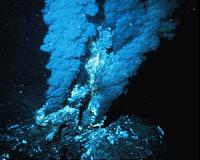| . |  |
. |
Jena, Germany (SPX) May 13, 2011 All animals move - cheetahs faster, snails more slowly. Muscle contractions are the basis of all movements, at least according to general opinion. But there are animal groups, that don't have any muscles at all, as they branched off from the evolutionary path before muscle cells evolved. However these animal groups, for instance the sea sponges, are not immovable. Sponges are able to contract without muscles. These contractions were already known to sponge divers in ancient Greece, as Aristotele described in 350 BC. A group of scientists headed by associate professor Dr. Michael Nickel of Friedrich Schiller University Jena (Germany) is looking into movement without muscles. The scientists from the Institute of Systematic Zoology and Evolutionary Biology are mostly interested in the evolutionary aspect, especially in the question: Which evolutionary forerunners did the muscle cells derive from? In a new study which will be published in the Journal of Experimental Biology (Band 214, doi: 10.1242/jeb.049148) on 15 May 2011, the evolutionary biologists are giving new answers to the question: Which cells in the sponges are contracting? In this paper the researchers are relying on the 3dimensional (3D) images, which they created with synchrotron radiation-based X-ray microtomography. Thus, the Jena scientists in co-operation with the Helmholtz-Zentrum Gesthacht at the Deutsches Elektronen Synchrotron Hamburg could compare and visualise the 3D structure of contracted and expanded sponges. "A key feature of our approach is the use of 3D data for measuring the volume and surface of our sponges," says Nickel. "Although the 3D volumetric analysis is widely known and used in the technical sciences, it has rarely been used in zoology - in spite of its enormous information potential." Thus, Nickel's team was able to show that the inner and outer surfaces - and therefore the epithelial cells, so-called pinacozytes, cause the strong body contractions of the sponges. So finally, the Jena scientists could also settle a hundred year old debate about the cause of cellular contractions. Until now far spindle-shaped cells in the tissue of sponges as well as epithelial cells have been thought to be possible 'candidates' - but now the Jena scientists could identify the true initiator of the contractions. The new findings of the researchers from Jena University make new approaches about the evolutionary development of musculature possible. "The early evolution of muscles has not been fully understood so far. According to current scientific knowledge muscle cells seem to have surfaced from nowhere", Nickel says. "But surely there must have been evolutionary predecessor systems, that have been unknown until now." The sponge epithelial cells are now moving to the forefront in the evolutionary biologists' further research into the context of this. "There is a lot of evidence that the sponge epithelial cells and the muscle cells of all the other animals are going back to a common contractile cellular predecessor." In future this will be analysed by international co-operations, by also using genome and gene expression related data. Michael Nickel et al.: "The contractile sponge epithelium sensu lato - body contraction of the demosponge Tethya wilhelma is mediated by the pinacoderm", Journal of Experimental Biology, Vol. 214, doi: 10.1242/jeb.049148.
Share This Article With Planet Earth
Related Links Friedrich-Schiller-Universitaet Jena Darwin Today At TerraDaily.com
 Growing on Fool's Gold
Growing on Fool's GoldMoffett Field CA (SPX) May 12, 2011 Similar to humans, the bacteria and tiny plants living in the ocean need iron for energy and growth. But their situation is quite different than ours - for one, they can't exactly turn to natural iron sources like leafy greens or red meat for a pick-me-up. So where does their iron come from? New research published by Nature Geoscience points to a source on the seafloor: minute particles (c ... read more |
|
| The content herein, unless otherwise known to be public domain, are Copyright 1995-2010 - SpaceDaily. AFP and UPI Wire Stories are copyright Agence France-Presse and United Press International. ESA Portal Reports are copyright European Space Agency. All NASA sourced material is public domain. Additional copyrights may apply in whole or part to other bona fide parties. Advertising does not imply endorsement,agreement or approval of any opinions, statements or information provided by SpaceDaily on any Web page published or hosted by SpaceDaily. Privacy Statement |